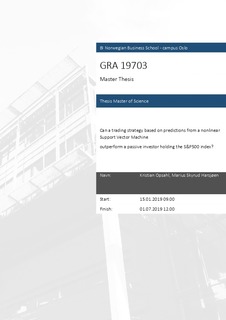Can a trading strategy based on predictions from a nonlinear support vector machine outperform a passive investor holding the S&P500 index?
| dc.contributor.author | Opsahl, Kristian | |
| dc.contributor.author | Harsjøen, Marius Skyrud | |
| dc.date.accessioned | 2019-10-18T08:43:53Z | |
| dc.date.available | 2019-10-18T08:43:53Z | |
| dc.date.issued | 2019 | |
| dc.identifier.uri | http://hdl.handle.net/11250/2623038 | |
| dc.description | Masteroppgave(MSc) in Master of Science in Finance - Handelshøyskolen BI, 2019 | nb_NO |
| dc.description.abstract | In this empirical research, we compare the forecasting performance of a supervised Support Vector Machine technique to a passive buy-and-hold strategy on the S&P500 index. By introducing two investment strategies, we find evidence that the application of a nonlinear Support Vector Machine can be superior to linear regression models, as well as to a passive buy-and-hold strategy. The Support Vector Machine model generates both excess returns and reduced volatility for the period between 2013 to 2019. However, when comparing the prediction results of a Support Vector Machine model to that of a linear regression model during the Great Recession, the results are ambiguous, although both models have proven to explicitly outperform the passive buy-and-hold approach. | nb_NO |
| dc.language.iso | eng | nb_NO |
| dc.publisher | Handelshøyskolen BI | nb_NO |
| dc.subject | finans | nb_NO |
| dc.subject | finance | nb_NO |
| dc.subject | financial economics | nb_NO |
| dc.title | Can a trading strategy based on predictions from a nonlinear support vector machine outperform a passive investor holding the S&P500 index? | nb_NO |
| dc.type | Master thesis | nb_NO |
Tilhørende fil(er)
Denne innførselen finnes i følgende samling(er)
-
Master of Science [1621]
